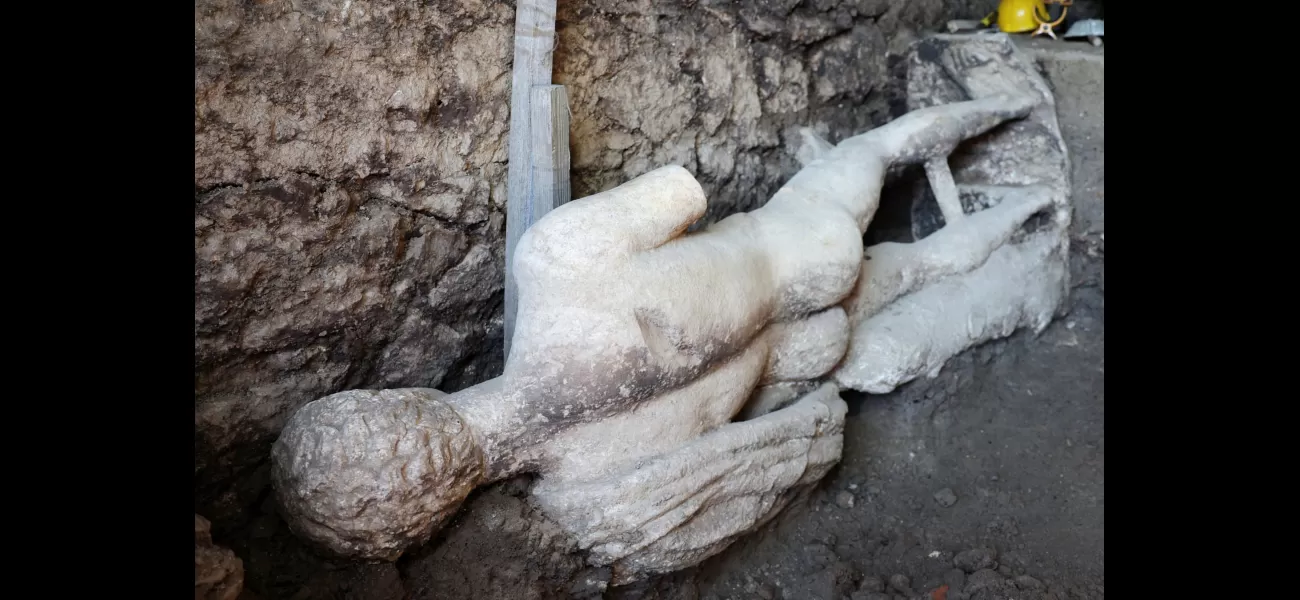After 1,500 years, a hidden Greek god of luck was discovered in a sewer.
The text is describing something as good or pleasant.
July 9th 2024.

Hidden deep within the dark, murky depths of a sewer, a statue of the Greek god Hermes lay waiting to be discovered. The very idea of excavating in such a place may have seemed unappealing, even to the most seasoned archaeologist, but the possibility of finding lost treasure or ancient coins was too tempting to resist.
To the surprise of the team in Bulgaria, their dig uncovered not trinkets of gold or silver, but the impressive marble figure of Hermes himself. Standing at an impressive two meters tall, the statue was remarkably well-preserved, with its smooth buttocks and finely detailed head still intact. It was a rare and exciting find, especially considering its location in the ancient city of Heraclea Sintica, nestled near the border of Greece.
According to the lead archaeologist, Lyudmil Vagalinski, the statue had been carefully placed in the sewers and covered with soil after an earthquake had devastated the city in 388 CE. This explained its remarkable condition, with only a few minor fractures on its hands. Vagalinski also noted that the statue was a Roman copy of the original Greek version.
As the team continued their delicate excavation around the statue, Vagalinski couldn't help but reflect on the religious significance of their discovery. Despite the city's adoption of Christianity as its official religion, it was clear that the people of Heraclea Sintica still held a deep reverence for their old gods. In fact, the statue of Hermes itself stood as a testament to the city's religious tolerance.
As Vagalinski explained, "Everything pagan was forbidden, and they had joined the new ideology, but apparently they took care of their old deities." It was a poignant reminder of the city's past and the resilience of its people.
Founded by the ancient Macedonian king Philip II of Macedon, Heraclea Sintica was once a bustling and prosperous city. However, after the earthquake, it fell into rapid decline and was ultimately abandoned around 500 CE. The discovery of the statue of Hermes was a glimpse into the city's glorious past and a reminder of its eventual fate.
Hermes, the god of trade, wealth, fertility, and many other domains, was also known as the inventor of the alphabet. He was a deity of great importance and was even believed to bring good luck to those who worshipped him. Perhaps it was this luck that allowed the statue to survive over 1,500 years in a sewer and be unearthed in such a remarkable condition.
In the end, the statue of Hermes served as a testament to the rich history and religious tolerance of Heraclea Sintica. It was a reminder of the city's past glory and a symbol of hope for future discoveries yet to be uncovered.
To the surprise of the team in Bulgaria, their dig uncovered not trinkets of gold or silver, but the impressive marble figure of Hermes himself. Standing at an impressive two meters tall, the statue was remarkably well-preserved, with its smooth buttocks and finely detailed head still intact. It was a rare and exciting find, especially considering its location in the ancient city of Heraclea Sintica, nestled near the border of Greece.
According to the lead archaeologist, Lyudmil Vagalinski, the statue had been carefully placed in the sewers and covered with soil after an earthquake had devastated the city in 388 CE. This explained its remarkable condition, with only a few minor fractures on its hands. Vagalinski also noted that the statue was a Roman copy of the original Greek version.
As the team continued their delicate excavation around the statue, Vagalinski couldn't help but reflect on the religious significance of their discovery. Despite the city's adoption of Christianity as its official religion, it was clear that the people of Heraclea Sintica still held a deep reverence for their old gods. In fact, the statue of Hermes itself stood as a testament to the city's religious tolerance.
As Vagalinski explained, "Everything pagan was forbidden, and they had joined the new ideology, but apparently they took care of their old deities." It was a poignant reminder of the city's past and the resilience of its people.
Founded by the ancient Macedonian king Philip II of Macedon, Heraclea Sintica was once a bustling and prosperous city. However, after the earthquake, it fell into rapid decline and was ultimately abandoned around 500 CE. The discovery of the statue of Hermes was a glimpse into the city's glorious past and a reminder of its eventual fate.
Hermes, the god of trade, wealth, fertility, and many other domains, was also known as the inventor of the alphabet. He was a deity of great importance and was even believed to bring good luck to those who worshipped him. Perhaps it was this luck that allowed the statue to survive over 1,500 years in a sewer and be unearthed in such a remarkable condition.
In the end, the statue of Hermes served as a testament to the rich history and religious tolerance of Heraclea Sintica. It was a reminder of the city's past glory and a symbol of hope for future discoveries yet to be uncovered.
[This article has been trending online recently and has been generated with AI. Your feed is customized.]
[Generative AI is experimental.]
0
0
Submit Comment





